Abstract
In the past, immunization programmes have focused primarily on rural areas. However, with the recognition of the increasing numbers of urban poor, it is timely to review urban immunization activities. This update addresses two questions: Is there any need to be concerned about urban immunization and, if so, is more of the same kind of rural EPI activity needed or are there specific urban issues that need specific urban strategies? Vaccine-preventable diseases have specific urban patterns that require efficacious vaccines for younger children, higher target coverage levels, and particular focus to ensure national and global eradication of poliomyelitis. Although aggregate coverage levels are higher in urban than rural areas, gaps are masked since capital cities are better covered than other urban areas and the coverage in the poorest slum and periurban areas within cities is as bad as or worse than that in rural areas. Difficult access to immunization services in terms of distance, costs, and time can still be the main barrier in some parts of the city. Mobilization and motivation strategies in urban areas should make use of the mass media and workplace networks as well as the traditional word-of-mouth strategies. Use of community health workers has been successful in some urban settings. Management issues concern integration of the needs of the poor into a coherent city health plan, coordination of different health providers, and clear lines of responsibility for addressing the needs of new, urbanizing areas.
Full text
PDF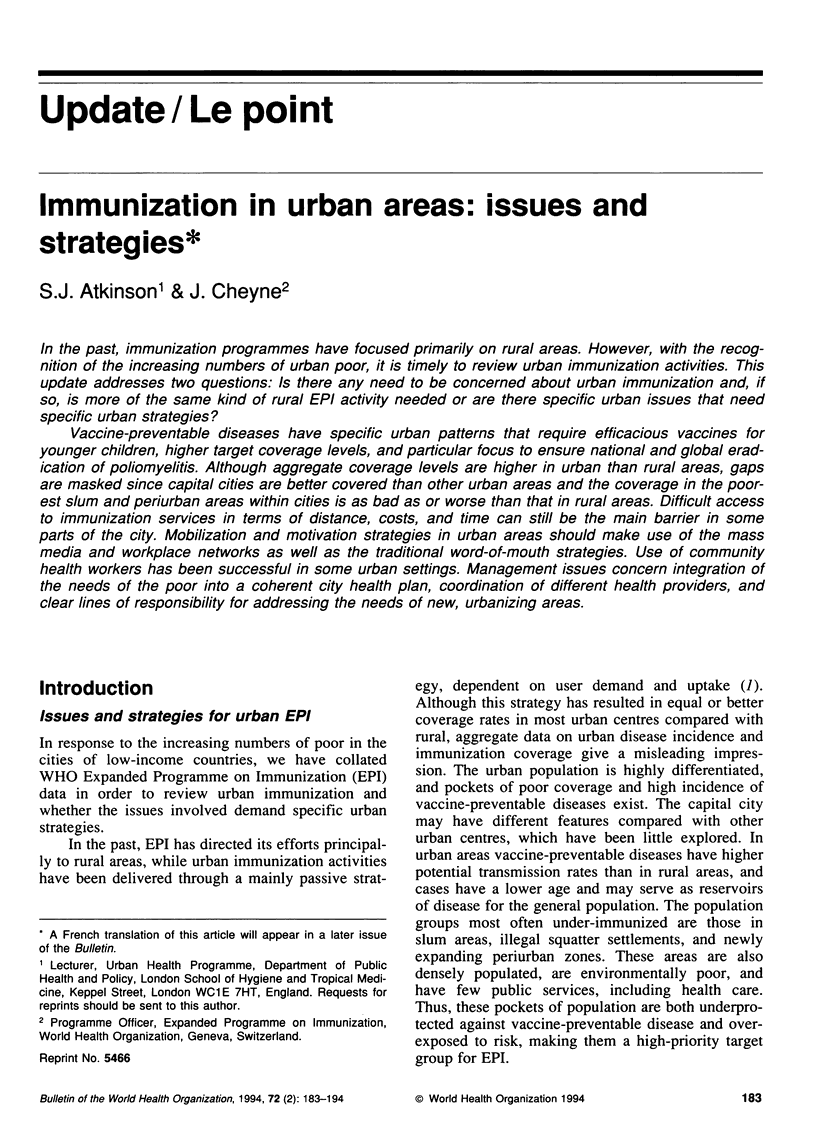
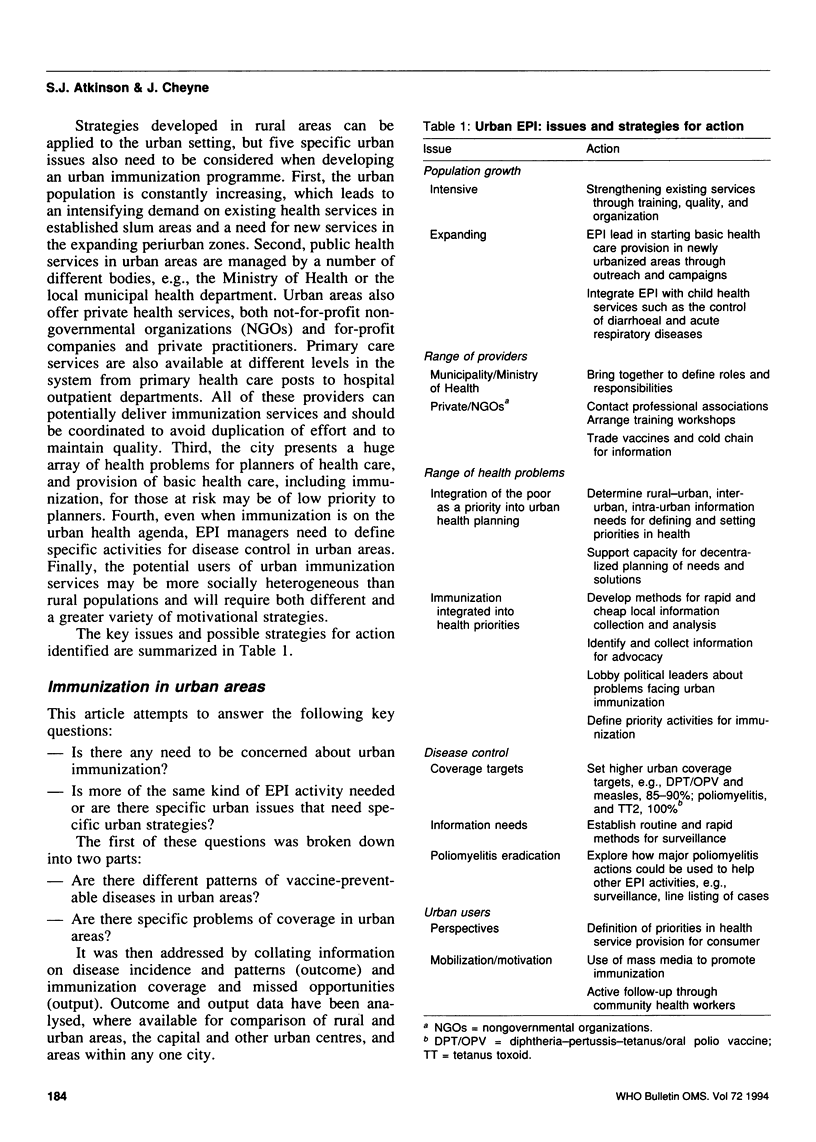
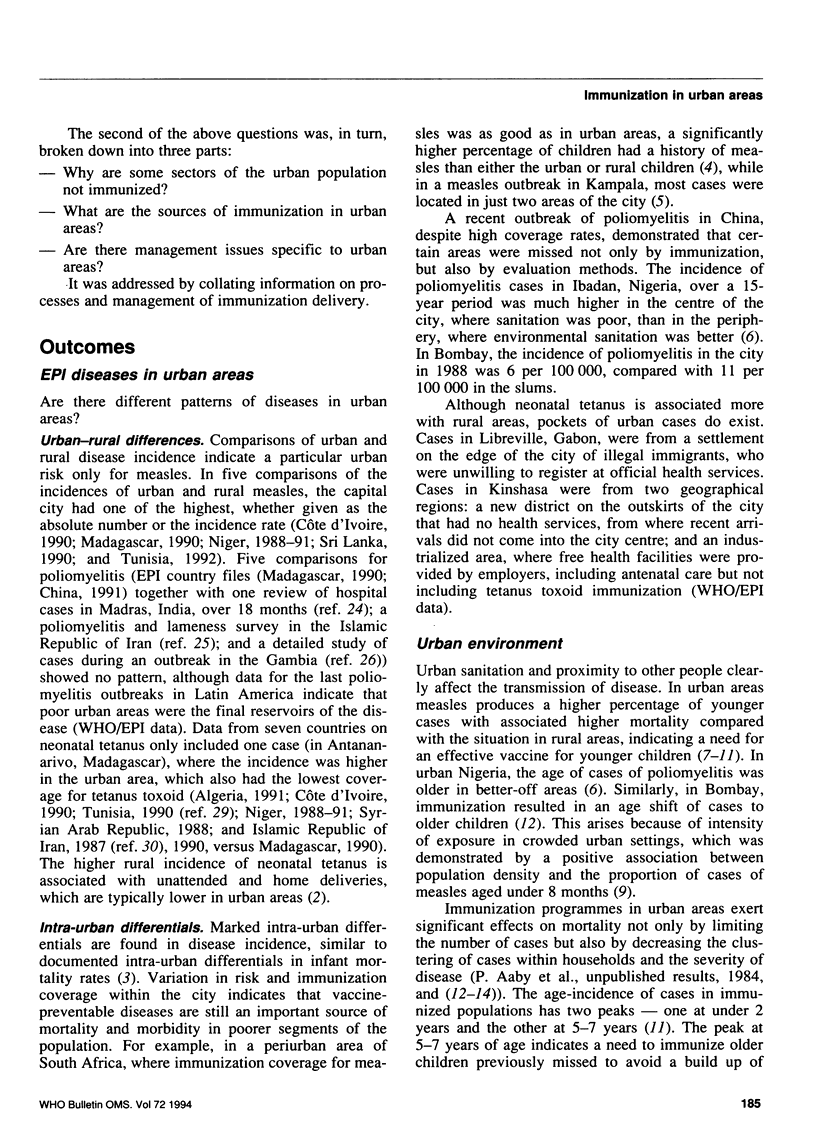
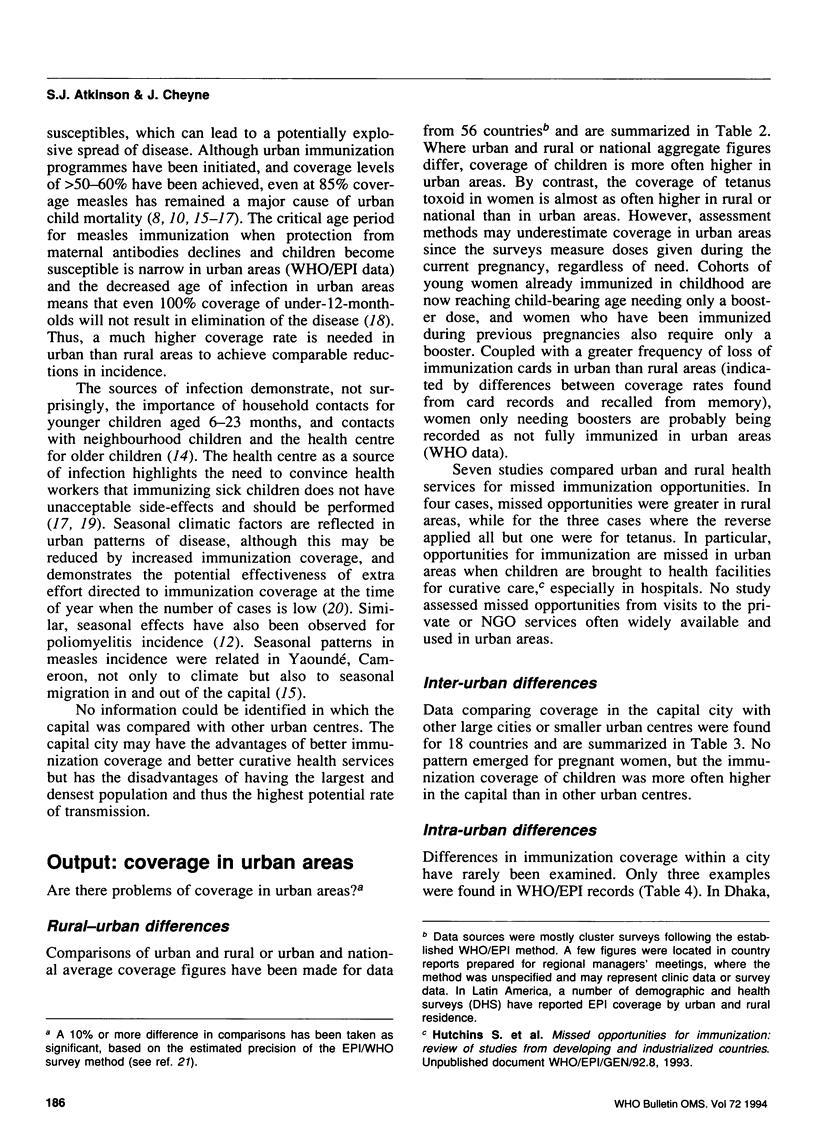
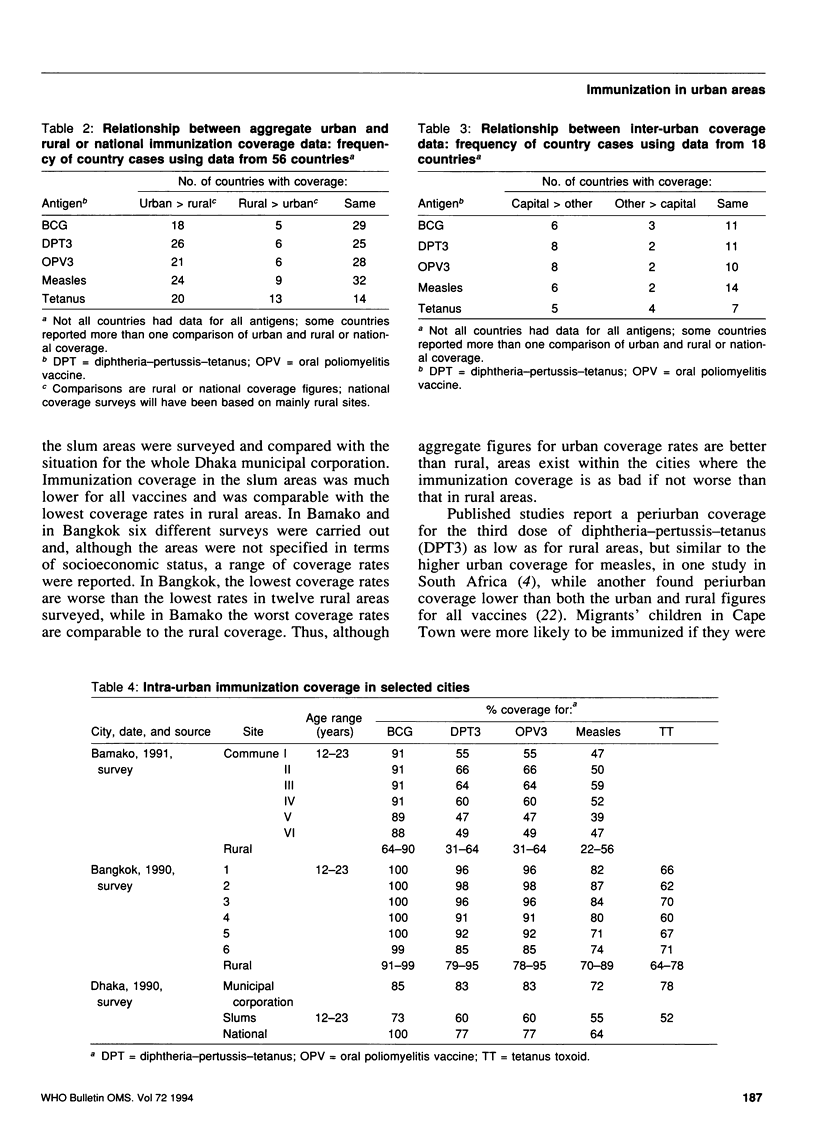
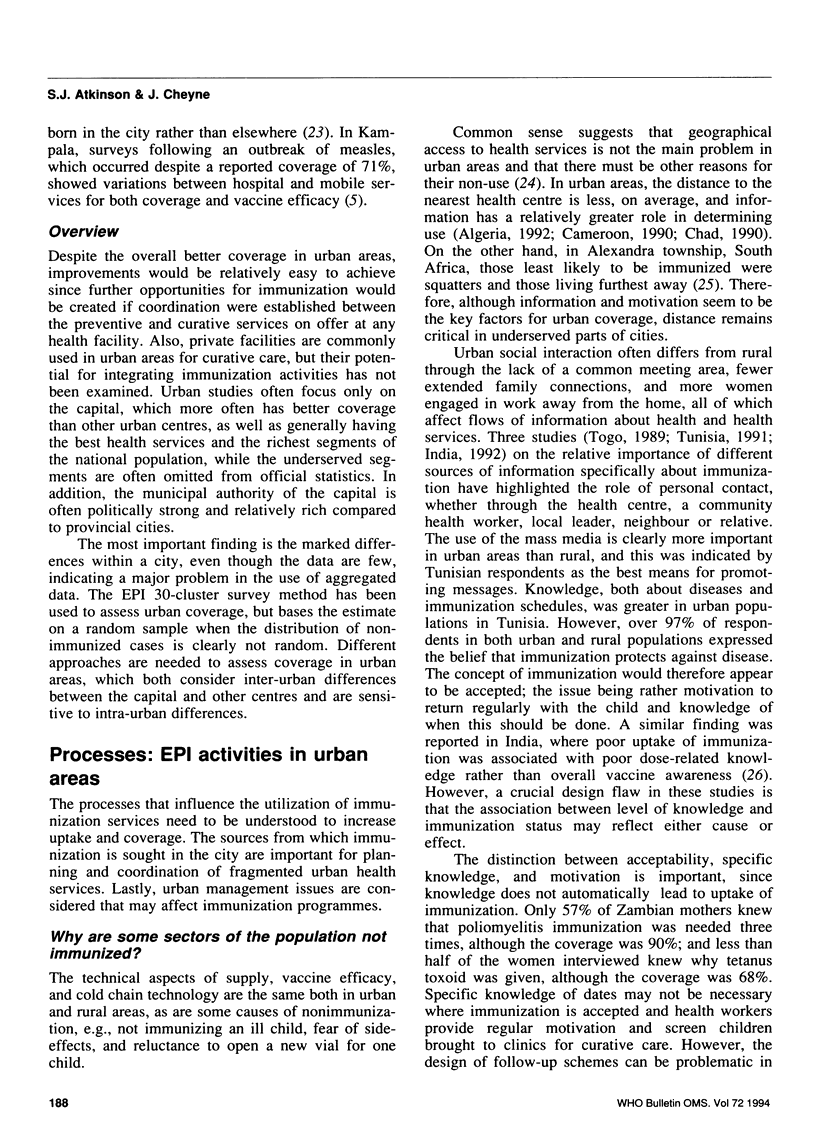
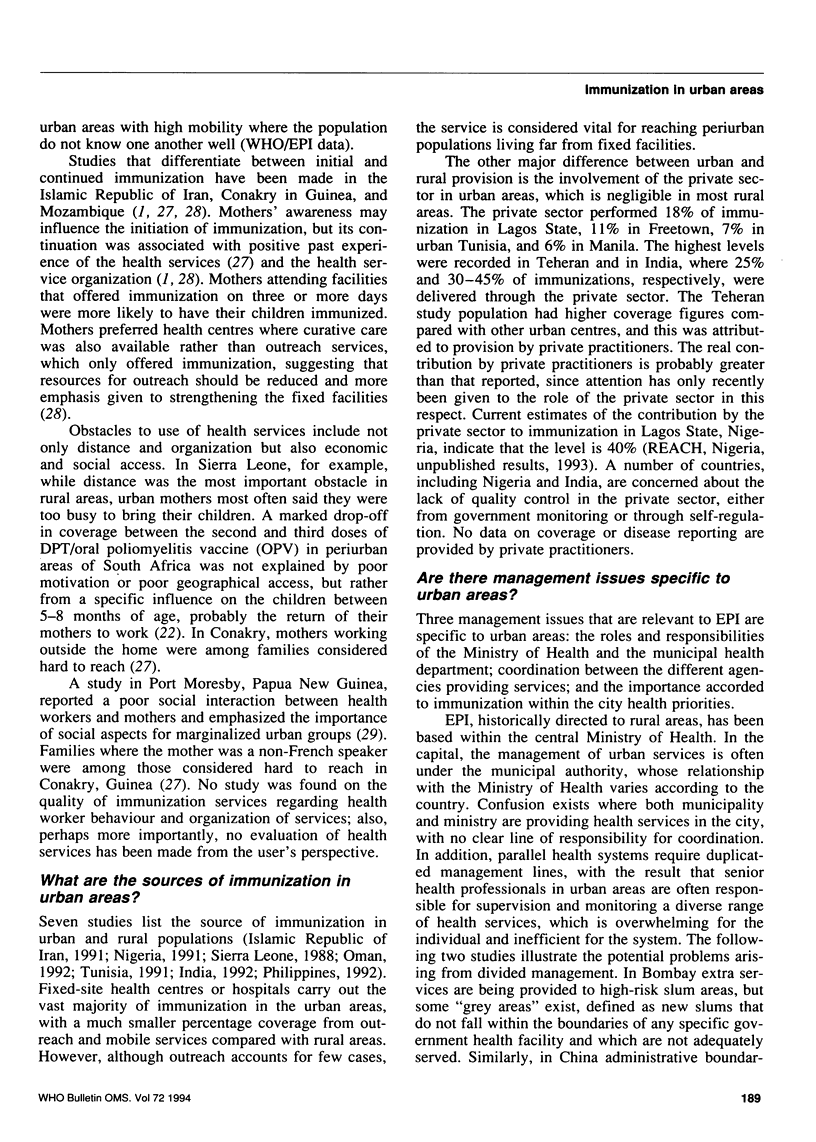
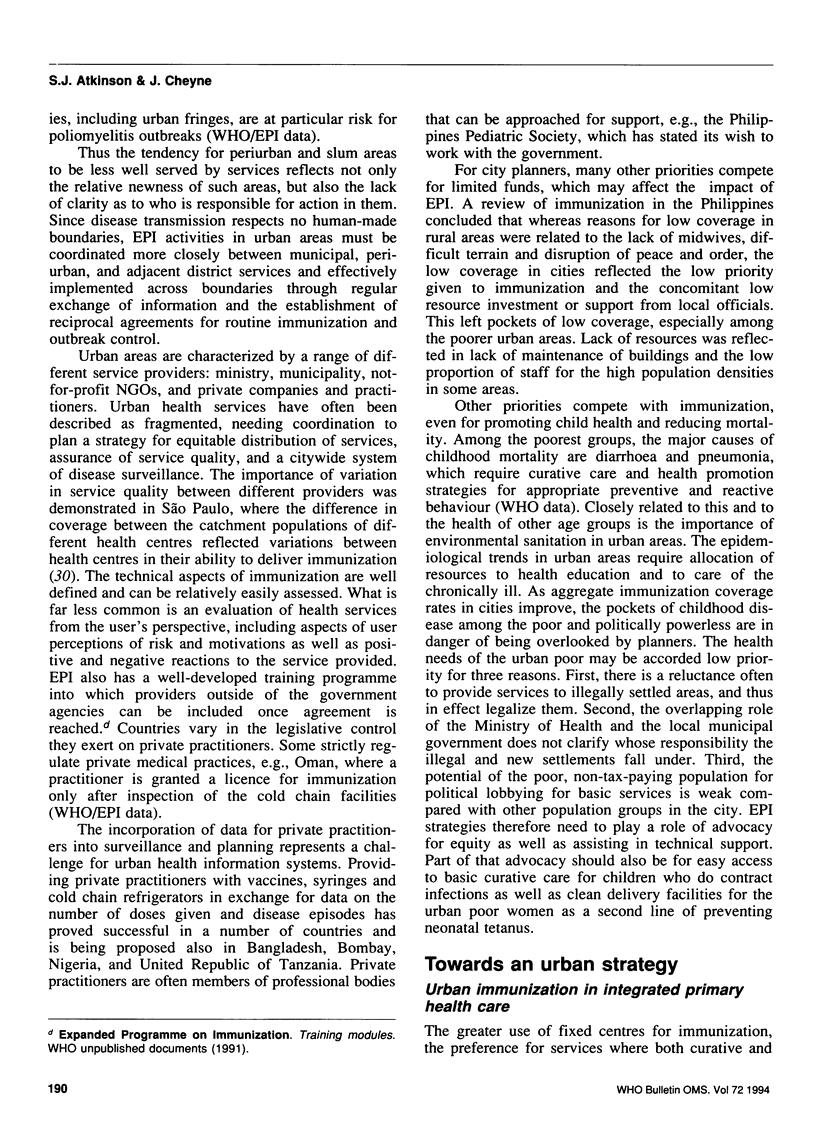
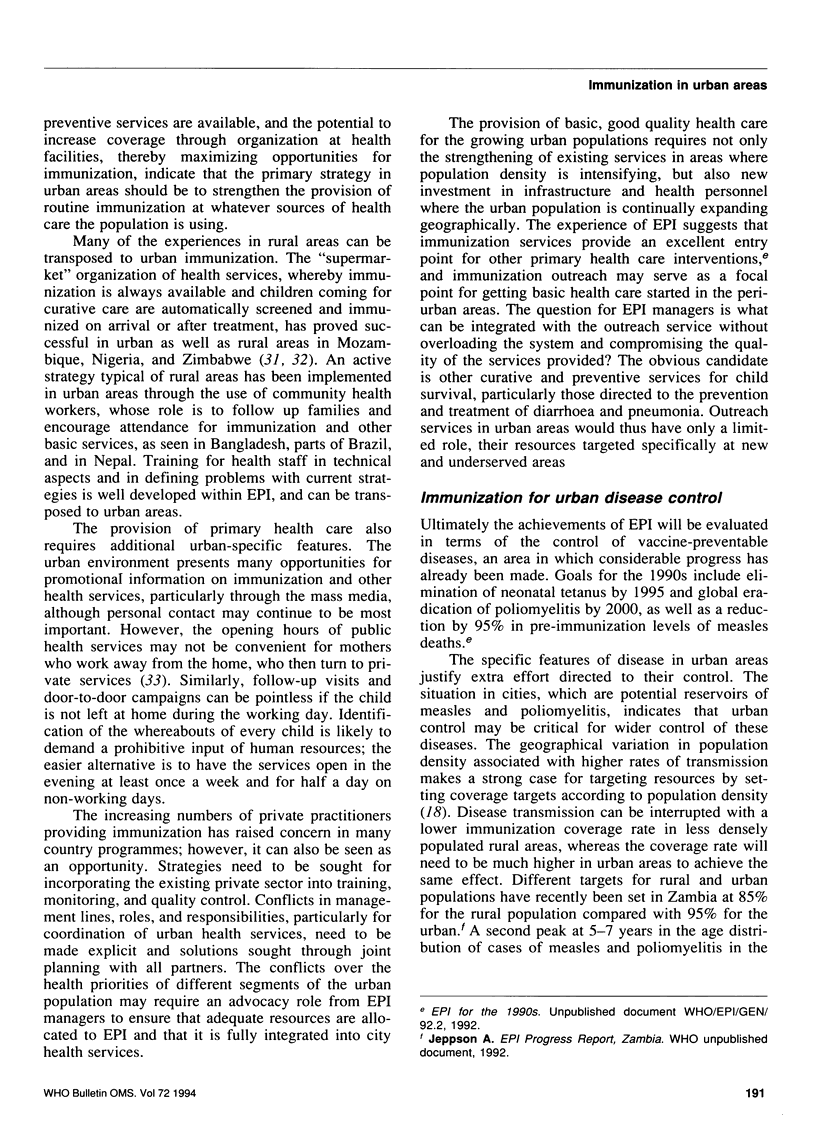
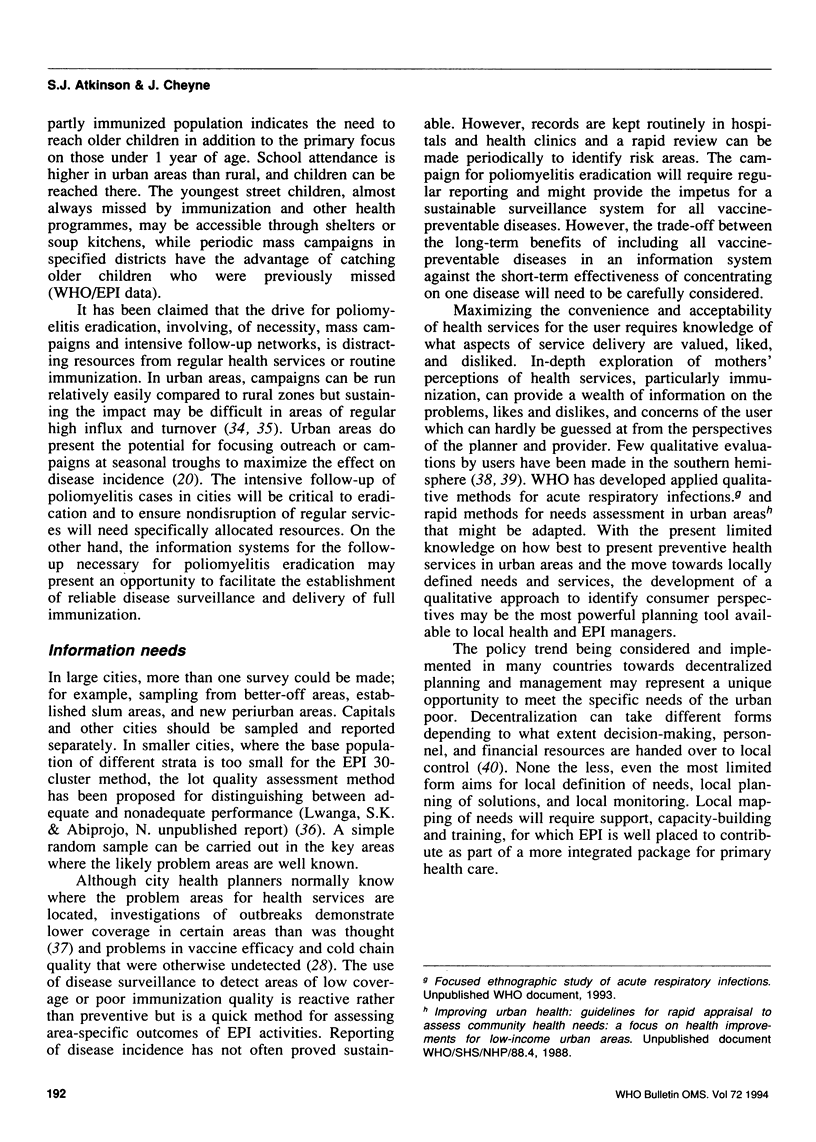
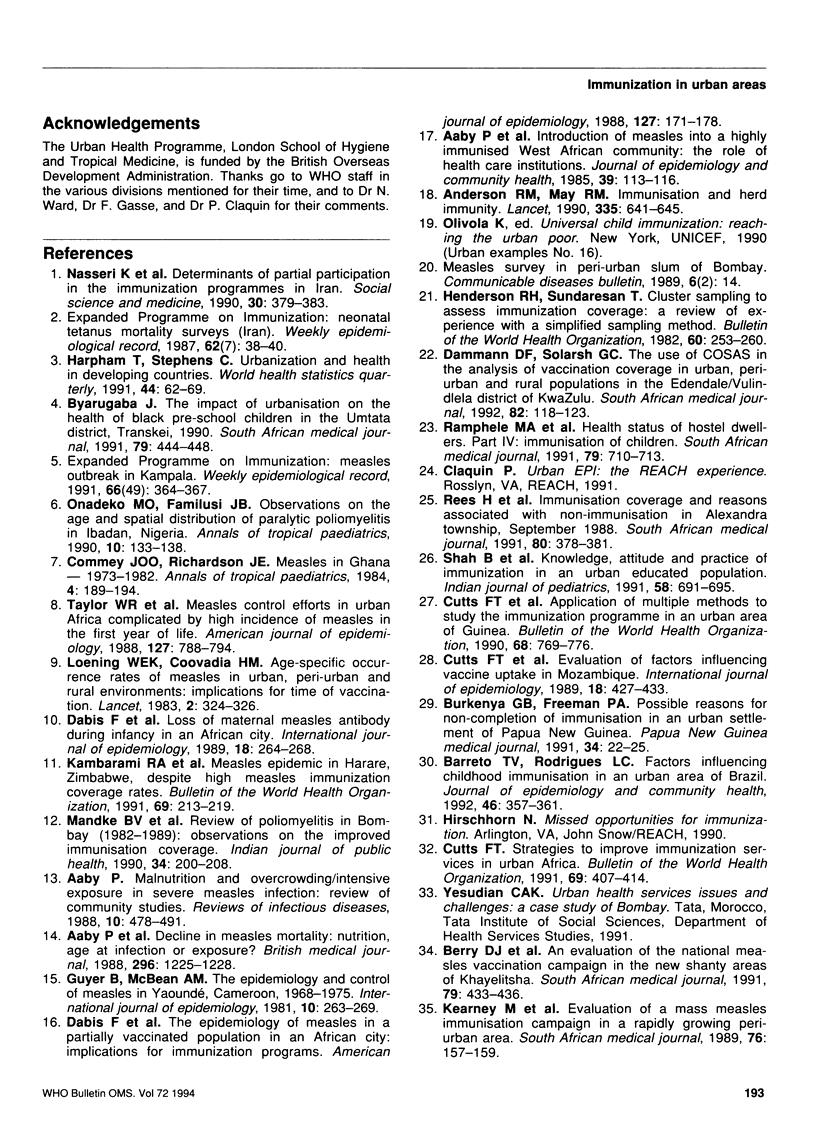
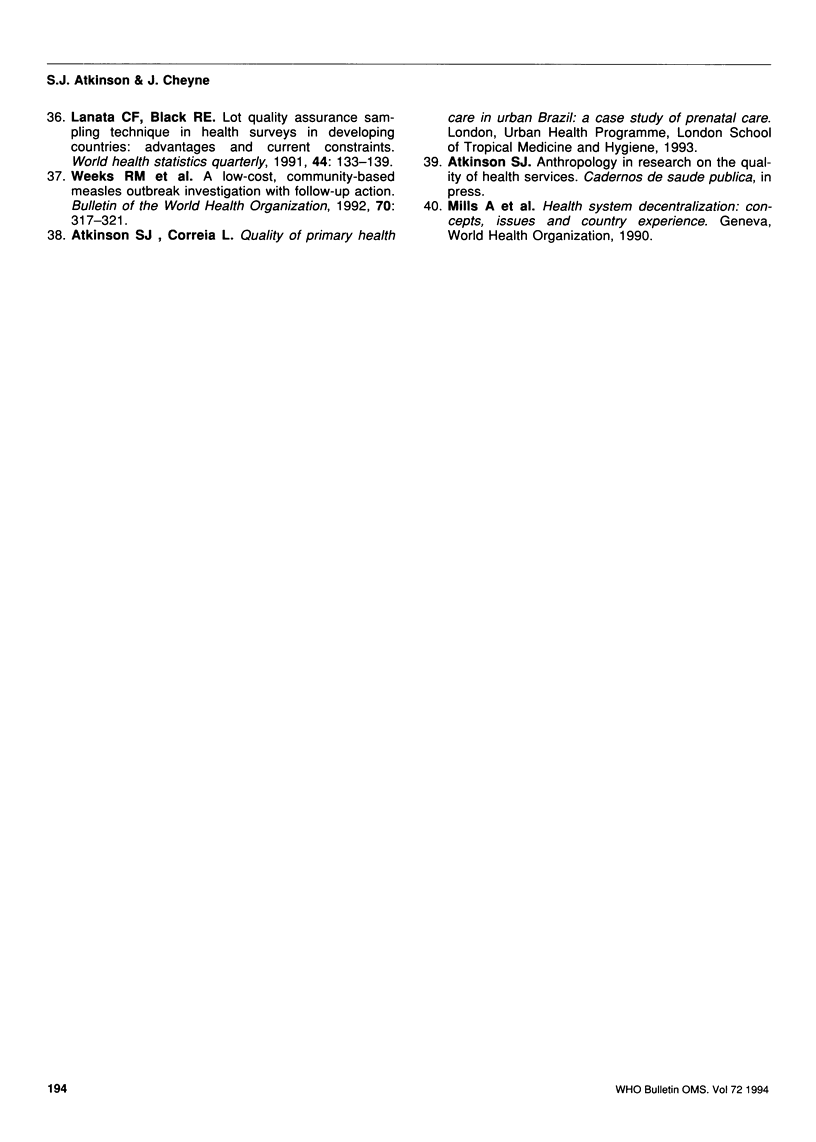
Selected References
These references are in PubMed. This may not be the complete list of references from this article.
- Aaby P., Bukh J., Lisse I. M., Smits A. J. Introduction of measles into a highly immunised West African community: the role of health care institutions. J Epidemiol Community Health. 1985 Jun;39(2):113–116. doi: 10.1136/jech.39.2.113. [DOI] [PMC free article] [PubMed] [Google Scholar]
- Aaby P., Bukh J., Lisse I. M., da Silva M. C. Decline in measles mortality: nutrition, age at infection, or exposure? Br Med J (Clin Res Ed) 1988 Apr 30;296(6631):1225–1228. doi: 10.1136/bmj.296.6631.1225. [DOI] [PMC free article] [PubMed] [Google Scholar]
- Aaby P. Malnutrition and overcrowding/intensive exposure in severe measles infection: review of community studies. Rev Infect Dis. 1988 Mar-Apr;10(2):478–491. doi: 10.1093/clinids/10.2.478. [DOI] [PubMed] [Google Scholar]
- Anderson R. M., May R. M. Immunisation and herd immunity. Lancet. 1990 Mar 17;335(8690):641–645. doi: 10.1016/0140-6736(90)90420-a. [DOI] [PubMed] [Google Scholar]
- Barreto T. V., Rodrigues L. C. Factors influencing childhood immunisation in an urban area of Brazil. J Epidemiol Community Health. 1992 Aug;46(4):357–361. doi: 10.1136/jech.46.4.357. [DOI] [PMC free article] [PubMed] [Google Scholar]
- Berry D. J., Yach D., Hennink M. H. An evaluation of the national measles vaccination campaign in the new shanty areas of Khayelitsha. S Afr Med J. 1991 Apr 20;79(8):433–436. [PubMed] [Google Scholar]
- Bukenya G. B., Freeman P. A. Possible reasons for non-completion of immunization in an urban settlement of Papua New Guinea. P N G Med J. 1991 Mar;34(1):22–25. [PubMed] [Google Scholar]
- Byarugaba J. The impact of urbanization on the health of black pre-school children in the Umtata district, Transkei, 1990. S Afr Med J. 1991 Apr 20;79(8):444–448. [PubMed] [Google Scholar]
- Commey J. O., Richardson J. E. Measles in Ghana--1973-1982. Ann Trop Paediatr. 1984 Sep;4(3):189–194. doi: 10.1080/02724936.1984.11748332. [DOI] [PubMed] [Google Scholar]
- Cutts F. T., Glik D. C., Gordon A., Parker K., Diallo S., Haba F., Stone R. Application of multiple methods to study the immunization programme in an urban area of Guinea. Bull World Health Organ. 1990;68(6):769–776. [PMC free article] [PubMed] [Google Scholar]
- Cutts F. T., Rodrigues L. C., Colombo S., Bennett S. Evaluation of factors influencing vaccine uptake in Mozambique. Int J Epidemiol. 1989 Jun;18(2):427–433. doi: 10.1093/ije/18.2.427. [DOI] [PubMed] [Google Scholar]
- Cutts F. T. Strategies to improve immunization services in urban Africa. Bull World Health Organ. 1991;69(4):407–414. [PMC free article] [PubMed] [Google Scholar]
- Dabis F., Sow A., Waldman R. J., Bikakouri P., Senga J., Madzou G., Jones T. S. The epidemiology of measles in a partially vaccinated population in an African city: implications for immunization programs. Am J Epidemiol. 1988 Jan;127(1):171–178. doi: 10.1093/oxfordjournals.aje.a114778. [DOI] [PubMed] [Google Scholar]
- Dabis F., Waldman R. J., Mann G. F., Commenges D., Madzou G., Jones T. S. Loss of maternal measles antibody during infancy in an African city. Int J Epidemiol. 1989 Mar;18(1):264–268. doi: 10.1093/ije/18.1.264. [DOI] [PubMed] [Google Scholar]
- Dammann D. F., Solarsh G. C. The use of COSAS in the analysis of vaccination coverage in urban, peri-urban and rural populations in the Edendale/Vulindlela district of KwaZulu. S Afr Med J. 1992 Aug;82(2):118–123. [PubMed] [Google Scholar]
- Guyer B., McBean A. M. The epidemiology and control of measles in Yaoundé, Cameroun, 1968-1975. Int J Epidemiol. 1981 Sep;10(3):263–269. doi: 10.1093/ije/10.3.263. [DOI] [PubMed] [Google Scholar]
- Harpham T., Stephens C. Urbanization and health in developing countries. World Health Stat Q. 1991;44(2):62–69. [PubMed] [Google Scholar]
- Henderson R. H., Sundaresan T. Cluster sampling to assess immunization coverage: a review of experience with a simplified sampling method. Bull World Health Organ. 1982;60(2):253–260. [PMC free article] [PubMed] [Google Scholar]
- Kambarami R. A., Nathoo K. J., Nkrumah F. K., Pirie D. J. Measles epidemic in Harare, Zimbabwe, despite high measles immunization coverage rates. Bull World Health Organ. 1991;69(2):213–219. [PMC free article] [PubMed] [Google Scholar]
- Kearney M., Yach D., Van Dyk H., Fisher S. A. Evaluation of a mass measles immunisation campaign in a rapidly growing peri-urban area. S Afr Med J. 1989 Aug 19;76(4):157–159. [PubMed] [Google Scholar]
- Lanata C. F., Black R. E. Lot quality assurance sampling techniques in health surveys in developing countries: advantages and current constraints. World Health Stat Q. 1991;44(3):133–139. [PubMed] [Google Scholar]
- Loening W. E., Coovadia H. M. Age-specific occurrence rates of measles in urban, peri-urban, and rural environments: implications for time of vaccination. Lancet. 1983 Aug 6;2(8345):324–326. doi: 10.1016/s0140-6736(83)90299-4. [DOI] [PubMed] [Google Scholar]
- Mandke B. V., Pawar R. M., Naik D. D., Torne V. P., Naiksatam A. M. Review of poliomyelitis in Bombay (1982-1989): observations on the improved immunisation coverage. Indian J Public Health. 1990 Oct-Dec;34(4):200–208. [PubMed] [Google Scholar]
- Nasseri K., Latifi M., Azordegan F., Shafii F., All-e-Agha R. Determinants of partial participation in the immunization programmes in Iran. Soc Sci Med. 1990;30(3):379–383. doi: 10.1016/0277-9536(90)90193-v. [DOI] [PubMed] [Google Scholar]
- Onadeko M. O., Familusi J. B. Observations on the age and spatial distribution of paralytic poliomyelitis in Ibadan, Nigeria. Ann Trop Paediatr. 1990;10(2):133–138. doi: 10.1080/02724936.1990.11747420. [DOI] [PubMed] [Google Scholar]
- Ramphele M. A., Heap M., Trollip D. K. Health status of hostel dwellers. Part IV. Immunisation of children. S Afr Med J. 1991 Jun 15;79(12):710–713. [PubMed] [Google Scholar]
- Rees H., Buch E., Ferrinho P. D., Groenewald H. T., Neethling A. Immunisation coverage and reasons associated with non-immunisation in Alexandra township, September 1988. S Afr Med J. 1991 Oct 19;80(8):378–381. [PubMed] [Google Scholar]
- Shah B., Sharma M., Vani S. N. Knowledge, attitude and practice of immunization in an urban educated population. Indian J Pediatr. 1991 Sep-Oct;58(5):691–695. doi: 10.1007/BF02820193. [DOI] [PubMed] [Google Scholar]
- Taylor W. R., Mambu R. K., ma-Disu M., Weinman J. M. Measles control efforts in urban Africa complicated by high incidence of measles in the first year of life. Am J Epidemiol. 1988 Apr;127(4):788–794. doi: 10.1093/oxfordjournals.aje.a114860. [DOI] [PubMed] [Google Scholar]
- Weeks R. M., Barenzi J. F., Wayira J. R. A low-cost, community-based measles outbreak investigation with follow-up action. Bull World Health Organ. 1992;70(3):317–321. [PMC free article] [PubMed] [Google Scholar]


